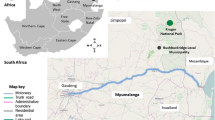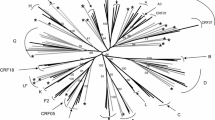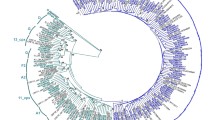Abstract
HIV-1 genetic diversity information from a pediatric population is scarce. This study enrolled 128 children living with HIV/AIDS, 103 antiretroviral-treated and 25 naive, from the Sao Paulo metropolitan area. Gag, pol and env regions were amplified, and drug resistance mutations, V3 loop, tropism and viral clades were evaluated. Drug resistance mutations among naïve children infected by vertical transmission were uncommon (4.2%), whereas most ARV-experienced children showed extensive mutation patterns. Clade B predominated at the pol region, but the analysis of the three regions concatenated showed 28% with BF mosaic structures. The most common V3 motif was GPGR, followed by GWGR in clade B samples and GPGQ in clade F samples. A predicted X4 phenotype was observed in 27%, without correlation to HIV clade. These findings expand the limited information on molecular characteristics of HIV-1 among children living with HIV/AIDS in the area and may provide information useful for monitoring the epidemic.



Similar content being viewed by others
References
UNAIDS/WHO, Joint United Nations Programme on HIV/AIDS (UNAIDS)/World Health Organization (WHO) (2007) AIDS epidemic update
Brasil. Ministério da Saúde. Secretaria de Vigilância em Saúde. Programa Nacional de DST e AIDS (2007) Boletim Epidemiológico DST/AIDS. Ano III, no 01—01a. à 26a. Semanas Epidemiológicas-janeiro a junho de 2007. Brasília (DF)
Los Alamos National Laboratory. HIV Sequence Database. Available at http://www.hiv.lanl.gov
Brindeiro RM, Diaz RS, Sabino EC et al (2003) Brazilian Network for HIV Drug Resistance Surveillance (HIV-BresNet): a survey of chronically infected individuals. AIDS 17:1063–1069
Brigido L, Nunes CC, Oliveira CM et al (2007) HIV-1 Subtype C and Cb Pol Recombinants prevail at the cities with the highest Aids prevalence rate of Brazil. AIDS Res Hum Retroviruses 23:1579–1585
Bongertz V, Bou-Habib DC, Brígido LF et al (2000) HIV-1 diversity in Brazil: genetic, biologic, and immunologic characterization of HIV-1 strains in three potential HIV vaccine evaluation sites. J Acquir Immune Defic Syndr 23:184–193
Brindeiro PA, Brindeiro RM, Mortensen C et al (2002) Testing genotypic e fenotypic resistance in human immunodeficiency vírus type 1 isolates of clade B and other clades from children failing antiretroviral therapy. J Clin Microbiol 40:4512–4519
Machado ES, Lambert JS, Watson DC et al (2004) Genotypic resistance and HIV-1 subtype in Brazilian children on dual and triple combination therapy. J Clin Virol 30:24–31
Sa Filho DJ, Sucupira MC, Casiero MM et al (2006) Identification of two HIV type 1 circulating recombinant forms in Brazil. AIDS Res Hum Retroviruses 22:1–13
Santos AF, Sousa TM, Soares EA et al (2006) Characterization of a new circulating recombinant form comprising HIV-1 subtype C and B in southern Brazil. AIDS 20:2011–2019
Caterino-de-Araújo A, Casseb J, Hendry MR (1999) Use of V3 loop peptide-specific antibody evaluation for subtyping HIV-1: results of a vertical transmission study from São Paulo, Brazil. J Trop Pediatr 45:265–270
Santoro-Lopes GS, Harrison LH, Tavares MD et al (2000) HIV disease progression and V3 serotypes in Brazil: is B different from B-Br? AIDS Res Hum Retroviruses 16:953–958
Casseb J, Komninakis S, Abdalla L et al (2002) HIV disease progression is the Brazilian variant B subtype B′ (GWGR motif) less pathogenic than US/European subtype B (GPGR)? Int J Infect Dis 6:164–169
Pope M, Haase AT (2003) Transmission, acute HIV-1 infection and the quest for strategies to prevent infection. Nat Med 9:847–852
Troyer RM, Collins KR, Abraha A et al (2005) Changes in human immunodeficiency virus type 1 fitness and genetic diversity during disease progression. J Virol 79:9006–9018
Richman DD, Bozzette SA (1994) The impact of the syncytium inducing phenotype of human immunodeficiency virus on disease progression. J Infect Dis 169:968–974
Ribeiro R, Hazenberg MD, Perelson AS, Davenport MP (2006) Naıve and memory cell turnover as drivers of CCR5-to-CXCR4 tropism switch in human immunodeficiency virus type 1: implications for therapy. J Virol 80:802–809
Tasca S, Ho S–H, Cheng-Mayer C (2008) R5X4 viruses are evolutionary, functional and antigenic intermediates in the pathway of SHIV coreceptor switch. J Virol. doi:10.1128/JVI.00570-08
Stuyver L, Wyseur A, Rombout A et al (1997) Line probe assay for rapid detection of drug-selected mutations in the human immunodeficiency virus type 1 reverse transcriptase gene. Antimicrob Agents Chemother 41:284–291
WHO-UNAIDS, World Health Organization (WHO)/Joint United Nations Programme on HIV/AIDS (UNAIDS) (2002) Guidelines for standard HIV isolation and characterization procedures
Sierra M, Thomson MM, Rios M et al (2005) The analysis of near full-length genome sequences of human immunodeficiency vírus type 1 BF intersubtype recombinant viruses from Chile, Venezuela and Spain reveals their relationship to diverse lineages of recombinant viruses related CRF12_BF. Infect Genet Evol 5:209–217
Oliveira T, Deforche K, Cassol S et al (2005) An automated genotyping system for analysis of HIV-1 and other microbial sequences. Bioinformatics 21:3797–3800
Swofford D (1999) Phylogenetic analysis with parsimony (and other methods), version 4.0b2a. Sinauer Associates Inc., Sunderland
Posada D, Crandall KA (1998) MODELTEST: testing the model of DNA substitution. Bioinformatics 14:817–818
Salminen MO, Carr JK, Burke DS et al (1995) Identification of breakpoints in intergenotypic recombinants of HIV type 1 by bootscanning. AIDS Res Hum Retroviruses 11:1423–1425
Fouchier RAM, Brouwer M, Broersen SM et al (1995) Simple determination of human immunodeficienty virus type 1 syncytium-inducing V3 genotype by PCR. J Clin Microbiol 33:906–911
Simonetti SRR, Schatzmayr HG, Simonetti JP (2003) Human immunodeficiency virus type 1: drug resistance in treated and untreated Brazilian children. Mem Inst Oswaldo Cruz 98:831–837
Machado DM, Fernandes SC, Succi RCM et al (2005) Analysis of HIV-type 1 protease and reverse transcriptase in Brazilian children failing highly active antiretroviral therapy (HAART). Rev Inst Med Trop Sao Paulo 47:1–5
Brígido LF, Franco HM, Custódio RM et al (2005) Molecular characteristics of HIV type 1 circulating in São Paulo, Brazil. AIDS Res Hum Retroviruses 21:673–682
Komninakis S, Fukumori L, Alcalde R et al (2007) Techniques used to identify the Brazilian variant of HIV-1 subtype B. Braz J Med Biol Res 40:301–304
Bandea CI, Ramos A, Pieniazek D et al (1995) Epidemiological and evolutionary relationship between Romanian and Brazilian HIV-1 subtypes F strains. Emerg Infect Dis 1:91–93
Coetzer M, Cilliers T, Ping LH et al (2006) Genetic characteristics of the V3 region associated with CXCR4 usage in HIV-1 subtype C isolates. Virology 356:95–105
de Brito A, Komninakis SC, Novoa P et al (2006) Women infected with HIV type 1 Brazilian variant, subtype B (B’-GWGR motif) have slower progression to AIDS, compared with patients infected with subtype B (B-GPGR motif). Clin Infect Dis 43:1476–1481
Acknowledgments
This work was partially supported by Sao Paulo State Foundation for Research Support (FAPESP) 00/09668-4, FAPESP 05/52017-8, Ministry of Health-Aids Program AS No. 4.159-2006 and CNPq No. 307730/2006-9.
Author information
Authors and Affiliations
Corresponding author
Additional information
Nucleotide sequence data reported are available in the GenBank database under the accession numbers EU189735, EU189737, EU189739–EU189743, EU189746–EU189748 and EU257861–EU258199.
Rights and permissions
About this article
Cite this article
de Oliveira, C.M., Almeida, F.J., Rodrigues, R. et al. High frequency of BF mosaic genomes among HIV-1-infected children from Sao Paulo, Brazil. Arch Virol 153, 1799–1806 (2008). https://doi.org/10.1007/s00705-008-0178-7
Received:
Accepted:
Published:
Issue Date:
DOI: https://doi.org/10.1007/s00705-008-0178-7




